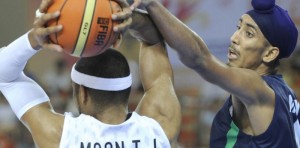
At the beginning of July, the International Basketball Federation (FIBA) told Sikh players that their religious turbans made of soft, pliable fabric violate their official rules, which state that,
Players shall not wear equipment (objects) that may cause injury to other players.
FIBA decided turbans were “dangerous” to other players based on no evidence.
Based on this logic, if the turban is dangerous, then so are the players’ jerseys, which are also made of cloth. Socks, sweatbands, and shoes laces are also all made of cloth, so it would make sense for FIBA to ban those articles too. Perhaps FIBA should make their players play in the nude.
You know…just to be safe.
What actually would protect players more than a turban [pullquote]Elbowing has led to more flagrant fouls and injuries in the NCAA than turbans ever have.[/pullquote]ban would be an elbow ban. FIBA should implement a mandatory elbow pad rule because elbows are hard, pointy, and dangerous. In fact, elbowing has led to more flagrant fouls and injuries in the NCAA than turbans ever have. In 2013, Creighton’s Dough McDermott elbowed Bearcats’ Shaquille Thomas in the face. In a game between Pittsburgh and Wichita State, Wichita’s Ron Baker hit Pitt’s Lamar Patterson in the face with his elbow. Marquette’s Trent Lockett elbowed Butler’s Alex Barlow in the chin. Cal’s Justin Cobbs elbowed UNLV’s Bryce Dejean-Jones. Wichita State’s Ehimen Orukpe elbowed Gonzaga’s Kelly Olynyk. Syracuse’s Brandon Triche elbowed Montana’s Jordan Gregory on the nose.
Before, during, and after 2013, turbans caused zero injuries to NCAA athletes.
As you can see, elbows are far more dangerous than turbans, yet FIBA has not addressed the very obvious safety concern of elbows. The fact that FIBA is targeting turbans makes me think this is not an issue of safety but an issue of racism.
The FIBA board consists of 70 percent white members and 30 percent non-white members. There are no board members of South Asian descent, especially from India — where Sikhism originated. The board members do not proportionally represent the diversity of their 213 member states. Based on the board’s lack of racial diversity and their recent ruling, perhaps they simply do not consider minority issues to be important. Are they simply handing down decisions merely to marginalize the “other”?
Such a misguided interpretation of the rules indicates that FIBA does not welcome those who do not fit their particular image of an athlete. It implies that Sikh religious beliefs are not respected. Furthermore, it sets a dangerous precedent. Banning Sikh expressions of faith is a slippery slope toward further acts of discrimination, bias, and shaming by FIBA towards not only Sikhs, but also other minority groups.
FIBA Secretary General Patrick Baumann said he wants FIBA’s[pullquote align=”right”]Excluding players based on religion is not “celebrating diversity.”[/pullquote] “message to be that basketball is everywhere,” and that FIBA wants to “…celebrates basketball as a global game in all its diversity.” Obviously, this particular interpretation of the rules contradicts the spirit of FIBA, as expressed by Baumann. Excluding players based on religion is not “celebrating diversity,” nor is it truly embracing the fact that basketball is everywhere and attracts players from the across the globe.
Disappointed that @FIBA irrationally bans the Sikh turban. Sports should bring people together not drive them apart. #LetSikhsPlay
— Amardeep Singh (@amarHoboken) July 16, 2014
Sports should bring people together, not exclude qualified atheletes. @FIBA end your turban ban and #LetSikhsPlay http://t.co/rUUK3lplX4
— Sikh Coalition (@sikh_coalition) July 16, 2014
Thanks to the supporters of the #LetSikhsPlay movement, FIBA will be meeting in late August to decide how to move forward on their turban policy. I hope it lives up to what it claims to stands for. To truly recognize basketball in all its diversity, FIBA needs to accept and allow the Sikh turban.
Lakhpreet Kaur is the editor-in-chief for Kaur Life, an online publication aimed at empowering Sikh women.













3 thoughts on “Is FIBA Discriminating Against Sikh Basketball Players With Anti-Turban Rule?”
Comments are closed.